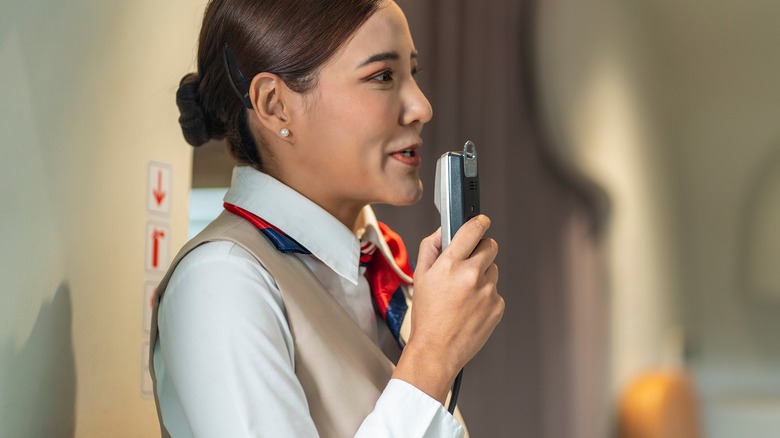The Specific Chime Sound You Never Want To Hear Mid-Flight, According To A Flight Attendant
Planes make a lot of noise. From the constant rumble of the jet engine to the banging you hear while boarding and the whirring of the air conditioning, they're not typically known for being the quietest form of transportation. However, there are certain noises that you might hear inside a plane that should be more cause for concern than others.
And no, it doesn't involve an alarm or blaring siren that'll startle everyone onboard — especially travelers who are trying to overcome their fear of flying. In fact, we're talking about something a little more subtle that you've probably heard before: that ding-dong, high-low chime that we're all inadvertently familiar with. If you've ever wondered what the mid-air dings each mean — you're in luck. Sharing his insider knowledge with his TikTok followers in a viral video that's been viewed more than 12 million times, flight attendant @tommycimato went all in to shed light on what these mysterious sounds actually mean — and why it's only time to worry if you ever hear three high-low tunes in a row.
Identifying the different types of chimes on a plane
In his video, Cimato breaks down the three types of tunes and what they all mean. Kicking things off with the most common sound — a single chime — he goes on to explain that it means a passenger is using their call button to get the flight attendant's attention either from their seat or the bathroom. Moving on to another common tune you're bound to hear on board a plane, Cimato explains that a single high-low tune typically means that a flight attendant is trying to call another flight attendant. Or that the flight deck — also known as the cockpit, the area of the aircraft where the pilots control the plane — is trying to reach the airplane staff.
Lastly, Cimato mentions one final sound — and it's one that you never want to hear while cruising at 30,000 feet above the air. So, what's the sound that should be reason for concern? If the same high-low tune plays three times in a row, it's the crew's way of communicating that there's an emergency on board. However, before you go about canceling all of your upcoming flights, Cimato adds that you'll probably "never have to hear that" anyway.
Other common airplane noises and what they mean
Aside from the dings and chimes, there are plenty of other common airplane noises that might sound concerning but, in reality, are just part of the normal flight process. Take the high-pitched whine and thumping that commonly happens right after takeoff. Alarming? Sure. Cause for concern? Not at all. The noises are just part of the plane's mechanism as the pilot retracts the plane wheels and closes the flap that protects them. And what about the engine revving after you've landed? No, that's not the captain preparing for an unexpected joy ride. It's actually the opposite, and they're just reversing the engine to slow down the plane.
Then, you've got the different types of phrases and terms commonly said by flight attendants and pilots that sound like a whole different language. From the standard "cabin crew, all call" — which instructs crew members to put on their headsets and await further instructions — to hearing the much-awaited "final approach" from the pilot — which signifies you're about 10-15 miles from your destination — there's a lot to decipher. Luckily, in most situations, the cabin crew and pilots are just communicating with each other that things inside the aircraft are happening as expected — meaning you can simply sit back and relax while you hit the skies.

